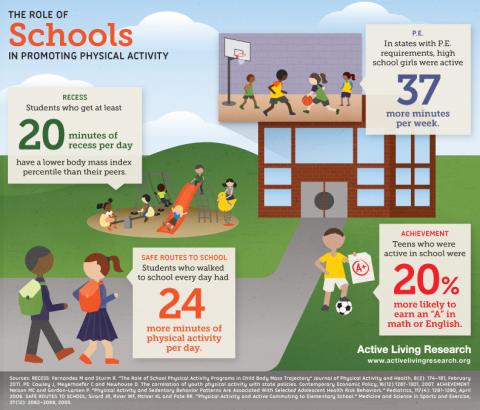
My six-year old son is in kindergarten. He's a bright and active boy who loves Star Wars, dinosaurs, raptors, and space. Try to sit him down for an extended period of time to learn about any of those things? Good luck. His teachers are saints.
And my son isn't alone. Kids have energy. They need to move and play. As parents, we know this. We are used to "getting the wiggles out" before dinner, taking activity breaks on long car rides, and in general recognizing that our kids are creatures-in-motion. Maybe - as a six-year old - my son is on the "more active" end of the spectrum. But I doubt it.
So I, like many other parents, totally understand why physical activity in school is SO important for our kids. It's common sense, right?
Yet surprisingly, it's not always the norm. In many schools, districts and states, many kids don't have access to regular physical activity classes, recess, and/or places to walk and play after school. These are all critical components of healthy communities.
Check out a few facts:
- Regular physical activity increases academic performance. Students who participate in regular activities do better on standardized tests, retain vocabulary, and concentrate better. There's also evidence showing higher-intensity aerobic activities might have the most positive impacts. [1]
- Just one session of physical activity can increase attention and behavior. [1]
- Children who have access to recreational equipment at their schools outside of the school day are more likely to be active. This is why policies and programs that promote the shared use of school resources after school, on weekends, and during the summer are so important, especially in lower-income communities. [2]
- Children at high risk for obesity, in particular children from lower-income families and/or who live in the southeast, are the least likely to have access to recess during their school day. This is a major public health concern, considering 1 in 3 kids in the US is at risk for health-related diseases like high blood pressure and diabetes. [3] We can do better.
- Children who attend regularly scheduled physical education (PE) classes get significantly more physical activity than those who attend PE less often. Regularly scheduled physical education programs that include the use of standardized curricula, goals for active classes and staff development can result in children who are more physically active. [4]
-
Safe Routes to Schools programs, that enable children to walk or bike to school for example, can not only get kids active but also lower health care and transportation costs for school districts and families. [5]
So as parents, what can we do? We can speak out about the importance of physical activity, recess, shared-use policies, safe routes to school, and more in our community. Here at MomsRising we'll be elevating local campaigns that can make a difference, and invite you to get in touch if you have ideas for others (email me at karen@momsrising.org).
Case in point: this month we're working with moms in Florida to highlight the importance of recess! If you're a Florida resident please add your voice here: http://action.momsrising.org/sign/fl-recess-petition/.
As parents, we do all we can to keep our kids healthy and active. Going to the park, walking or hiking as a family, or a snowy day even just building fun obstacle courses around the house works great for my son. But he's part of a bigger community, and his school day is an equally important part of the equation. Healthy schools are a win-win for everyone. I'm excited to see how we, as parents, can ensure they're the norm rather than the exception.
Sources:
[1] Active Education: Growing Evidence on Physical Activity and Academic Performance. Brief from Active Living Research.
[2] Promoting Physical Activity through the Shared Use of School and Community Recreational Resources. Brief from Active Living Research.
[3[ Increasing Physical Activity through Recess. Brief from Active Living Research.
[4] School Policies on Physical Education and Physical Activity. Brief from Active Living Research.


The views and opinions expressed in this post are those of the author(s) and do not necessarily reflect those of MomsRising.org.
MomsRising.org strongly encourages our readers to post comments in response to blog posts. We value diversity of opinions and perspectives. Our goals for this space are to be educational, thought-provoking, and respectful. So we actively moderate comments and we reserve the right to edit or remove comments that undermine these goals. Thanks!